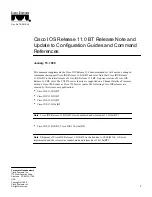
727
Programming Operations Guide
Chapter 35
Configuring QoS monitor
The IP telephony Quality-of-Service (QoS) Monitor periodically monitors the delay and
packet-loss of IP networks between two peer gateways. The Business Communications Manager
QoS Monitor uses the same method as the Meridian 1 IPT. These monitoring packets are delivered
at UDP port 5000.
This section explains how to set the monitor and how to view the mean opinion score:
•
“Setting the QoS monitor” on page 729
•
“Viewing the QoS Monitor Mean Opinion Score” on page 729
How QoS monitoring works
There are 25 monitoring packets traveling in each direction every 15 seconds. Each monitoring
package has 88 bytes in the IP layer. These monitoring packets are equally spaced out in the
15-second interval. During this 15-second interval, the packets are sent from transmitting Business
Communications Manager system to the receiving system and then returned to the transmitting
Business Communications Manager system. This results in an
overhead
in the IP layer of 293
bytes/second in one direction [(2x25x88)/15 = 293 bytes/second].
QoS Monitor works on a gateway between two Business Communications Manager systems or
between a Business Communications Manager system and a Meridian 1 IPT system. QoS Monitor
must be enabled on both ends of the connection.
For information about how to configure remote gateways, refer to the
Business Communications
Manager IP Telephony Configuration Guide
.
The main objective of the QoS Monitor is to allow new IP telephony calls to fall back to the PSTN
if the IP network is detected as “bad”.
Note:
The remote gateways are identified by their Published IP Addresses. If a remote
gateway is accessed through an interface with Network Address Translation (NAT)
configured, the Published IP Address must be the same as one of the Public IP Addresses.
For information about NAT, refer to
“Configuring NAT (Network Address Translation)”
on page 737
.
Summary of Contents for BCM 3.7
Page 4: ...4 Software licensing N0008589 3 3...
Page 32: ...32 Contents N0008589 3 3 W 937 Index 939...
Page 46: ...46 Tables N0008589 3 3...
Page 64: ...64 How to get help N0008589 3 3...
Page 90: ...90 Manually activating Telnet N0008589 3 3...
Page 116: ...116 Delayed system restart N0008589 3 3...
Page 194: ...194 Configuring a data module N0008589 3 3...
Page 276: ...276 Setting line telco features N0008589 3 3...
Page 310: ...310 Using COS passwords N0008589 3 3...
Page 364: ...364 Enhanced 911 E911 configuration N0008589 3 3...
Page 380: ...380 Renumbering DNs N0008589 3 3...
Page 398: ...398 Saving wizard pages on your computer N0008589 3 3...
Page 458: ...458 Voice Mail settings N0008589 3 3...
Page 488: ...488 Setting system telco features N0008589 3 3...
Page 508: ...508 Other programming that affects public networking N0008589 3 3...
Page 522: ...522 PRI networking using Call by Call services N0008589 3 3...
Page 592: ...592 Monitoring Hunt groups N0008589 3 3...
Page 636: ...636 Configuring Double Density N0008589 3 3...
Page 640: ...640 Using the Network Update Wizard N0008589 3 3...
Page 666: ...666 Importing and Exporting DHCP data N0008589 3 3...
Page 722: ...722 Restarting the router N0008589 3 3...
Page 726: ...726 Important Web Cache considerations N0008589 3 3...
Page 748: ...748 Configuring an Interface with NAT N0008589 3 3...
Page 794: ...794 IPSec N0008589 3 3...
Page 818: ...818 Configuring the Policy Agent characteristics N0008589 3 3...
Page 832: ...832 Firewall rules for Business Communications Manager with Dialup interfaces N0008589 3 3...
Page 876: ...876 ISDN Programming N0008589 3 3...
Page 1004: ...1004 Index N0008589 3 3...
















































